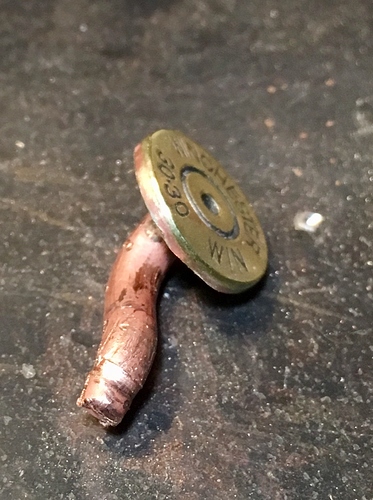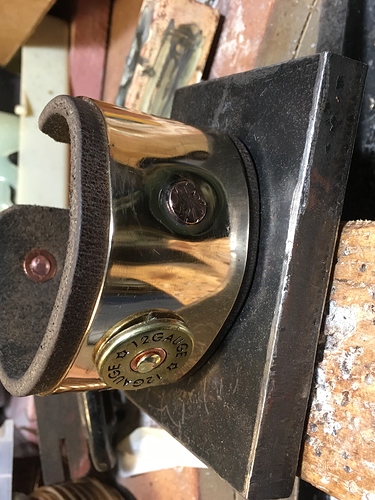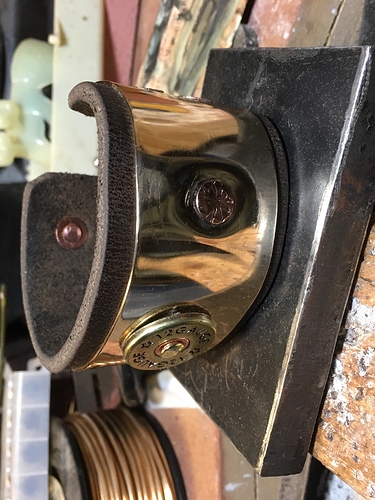I make bracelets and belt buckles. I recently came up with what seemed like a great idea…failed. I soldered the bullity end of a shell to the end of a copper rivet, so far good. The copper softened too much and bent when riveting. Any thoughts on hardening the copper after solderimg?
Thanks,
Randy
I would like to see a pic of the rest of what this has to go into or with.? Buckles you say?
I too make buckles, but in sterling and bronze.
Also the brass piece is the primer end of the round, or not so?
If copper is too soft you cant re harden it to any useable extent.
go to using a brass rivet. they are available, certainly here in the UK. Can you specify the rivet dia and length from under the head?
Or make your own from brass 1/8in dia welding wire.
thats done with a 2part split die make from some iron angle hinged so it locates together when held in you third hand, your leg vice. An engineers bench vise isnt designed to be hammered on.
await your reply.
Ted.
Thought for today,
Dont be afraid to hit it!
Hi Ted, I think I will try brass rivets next time. I finished it anyway, kind of of plain, but I like it. Thanks for the help!
Randy I believe once heated Cooper is only hardened by impact. Go to Google and look for riveting Hull planning for small boat construction. The river and rove process may help with success full copper riveting.
Don Meixner
Sent from my Verizon 4G LTE Droid
Rivets can be made from copper tubing,
flare the end and use snap rivet tools to finish
the end.
Look on EBay at snap rivet tools for the
assortment of punches and the plate used to
hold the head of the rivet.
Hi Randy,
We’ll have another go!.
Don’s imput to using solid rivets as per wooden boat assembly, is one way to go.
What happens with his technique is the rove or washer is concave side to the wood or in your case the leather,
the hole through the washer is a fraction smaller than the rivet dia. essential in any rivetting to soft mateerial.
A hollow punch drives the washer tight down onto the wood or leather, snips cut off surplus rivet leaving say 1/16th in proud, then a ball peen hammer is used to upset the rivet
over the washer.
The brass washer in your picture has far to big a hole for the rivet.
Hope this helps
Ted.
Rivets of any metal work best when work hardened. If they are soft they
bend rather than peen over.
-Jo
Jo,
How are copper rivets hardened?
Rivets bend like that, not because they may have been annealed, but because of several variables. One, the rivet may have been too long. Two, the rivet did not fit snugly into the hole(s) through which it was inserted. Annealed rivet wire is easier to upset (the tapping down of the rivet) than work hardened wire, so don’t worry about the fact that the rivet wire may be annealed. Also, a properly upset length of rivet wire becomes slightly work-hardened during the process of upsetting it.
THE LENGTH OF THE RIVET
The length of a rivet is determined by the diameter of the rivet wire. A good rule for rivet length is that the rivet should not extend beyond the exit from the hold more than ca. 1/2 the thickness of the rivet wire. You don’t need calipers to measure this, just eyeball it. It’s a little more difficult when you are joining softer materials (like leather to metal), because the material tends to compress, but you can take this into account as you trim your rivet wire to the correct length.
THE HOLE FOR THE RIVET
The hole for the rivet must match the diameter of the rivet wire, as closely as possible. To achieve this accurately, it helps to use a drill gauge. Insert the rivet wire into the hole in the drill gauge into which the rivet wire fits snuggly. Choose a drill bit that is the size that fits into the same hole. I generally will choose a drill bit that is close to that size, but a little larger, just so I don’t have to struggle inserting the rivet. Rule of thumb, though, is to choose the drill bit to match the diameter of the rivet exactly. If that hole tends to resist the insertion of the rivet, you can very slowly enlarge that opening using a round needle file or a very small steel cylinder bur. Alternatively, if the hole is too snug for the rivet wire, try waxing the rivet with beeswax, which will help the rivet slide through the several openings. Hope this helps.
You can hold the end of the wire while holding the cap end then give it a turn or two to harden. Also, if you drill your hole after you solder, and the size is not critical, you can give a little tug and that will work harden a little but will stretch the wire.
“Rivets of any metal work best when work hardened. If they are soft they
bend rather than peen over.”
Jo, I am going to agree with you only 50%.
I only like work hardened rivets in soft, thick materials such as leather. In my jewelry work, I always strive to make sure the length of my rivets when trimmed are only 1.5 times the diameter. If I am using a washer, than no more than 2 times the diameter.
If I have a thicker pile of materials, I use a larger diameter rivet. I rarely if ever have a rivet bend on me.
I honestly do not remember where I learned about keeping the length to 1.5X or 2X the diameter, but it has served me well over the years.
Gerald A. Livings
Livingston Jewelers
Great advice, Linda. I personally love rivets as a way to add decorative elements to a piece (Easily Distracted by Shiny Objects - Alec Kercsó - #12 by Alec).
Another way to help a snug rivet fit is to turn the rivet while holding the shaft in a fold of fine sandpaper to minimally reduce its diameter. I prefer this to enlarging the hole, because if I mess something up (like making the hole a little too large), its not the majority of the piece that’s damaged, just the single element.
Alec
Hi Alec, I like the idea of gently rotating the rivet in fine sandpaper (emery paper?). My rivets are quite small and would preclude that technique, which is why a very gently will enlarge the hole instead.One doesn’t need to remove much material from the opening. It’s just a very little that would need to be removed generally, since I do carefully match the drill bit to the rivet diameter.
Hi Linda,
I can see how it would be difficult to rotate short rivets in a piece of sandpaper. At the time of insertion, mine are fairly long; I slide them into their holes and snip them off at the desired height. They don’t have true heads, but instead, I upset both ends at the same time, positioning each inserted rivet on a domed mushroom stake and striking it with a planishing hammer.
I remembered one more reason I used the approach I described. Even with my really nice Swanstrom Super-Flush side cutters, the end of the rivet was slightly out of round, making it difficult to slide into that high-tolerance hole.
Anyway, that’s the beauty of good craftsmanship, right? All roads lead to Rome.
Best,
Alec



